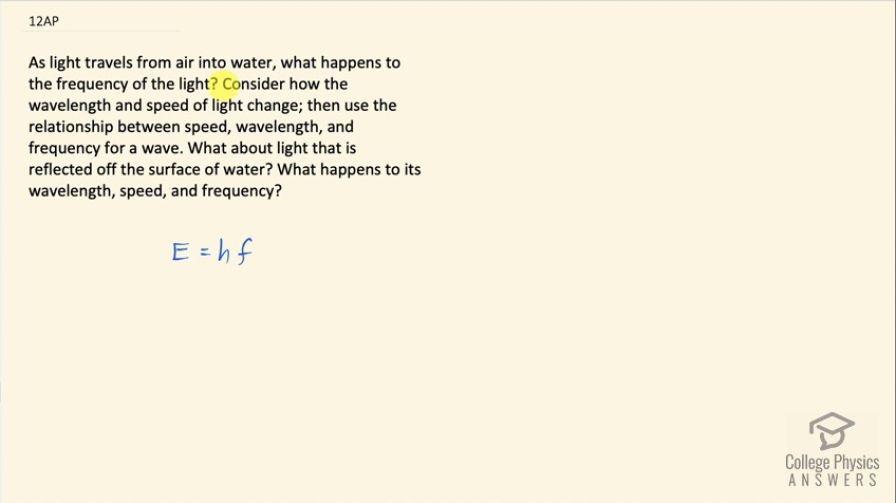Question
As light travels from air into water, what happens to the frequency of the light? Consider how the wavelength and speed of light change; then use the relationship between speed, wavelength, and frequency for a wave. What about light that is reflected off the surface of water? What happens to its wavelength, speed, and frequency?
Final Answer
Please see the solution video.
Solution video
OpenStax College Physics for AP® Courses, Chapter 25, Problem 12 (Test Prep for AP® Courses)

vote with a rating of
votes with an average rating of
.
Video Transcript
This is College Physics Answers with Shaun Dychko. When light travels from air into water, what happens to the frequency of the light? Now the question is suggesting that we think about how the wavelength and speed of the light changes and then use that to figure out something about the frequency but doing so results in a circular argument and I think a better way to approach this is to think about the energy of a single photon which is Planck's constant times the frequency of the light and use the idea that this energy has to be conserved. So when the light is going into different media while the intensity of the beam can certainly change because different media could absorb some of that some energy from the beam intensity, the energy of each single photon won't change because when you know you have some medium you would expect after transitioning through a medium and you return back into the air suppose this is air out here and here is water and then back into water, we would expect the color here to be the same as the color originally and if it is the same color then we know all the energy has been conserved then because the color is proportional, you know, is related to frequency and so the energy will be the same on the beginning side and on the ending side because it's now the same color and it's returned to the same medium and energy is conserved and likewise, in here, it will have to have the same energy. Okay! Now the speed in this medium will be different and speed is frequency times wavelength so given that the speed changes and frequency has to be constant then that means the wavelength has going to have to change in order to result in a different speed of the wave through this medium. And what happens when it's reflected off the surface of water? Well, nothing changes because its color and its speed... its wavelength and frequency in other words... will remain constant because it's remaining in the same medium.